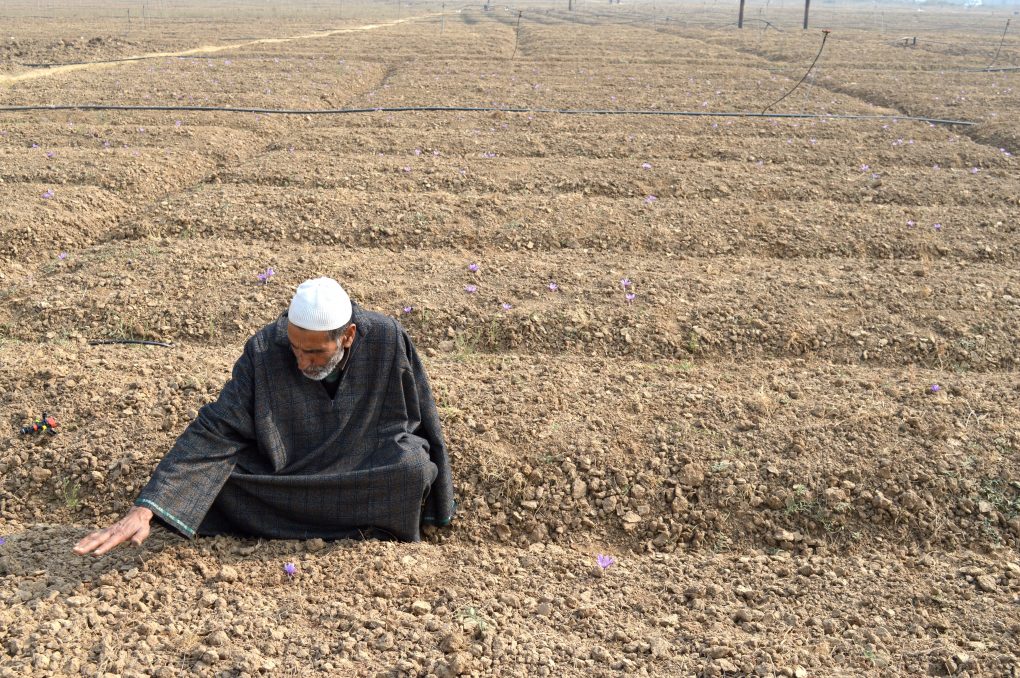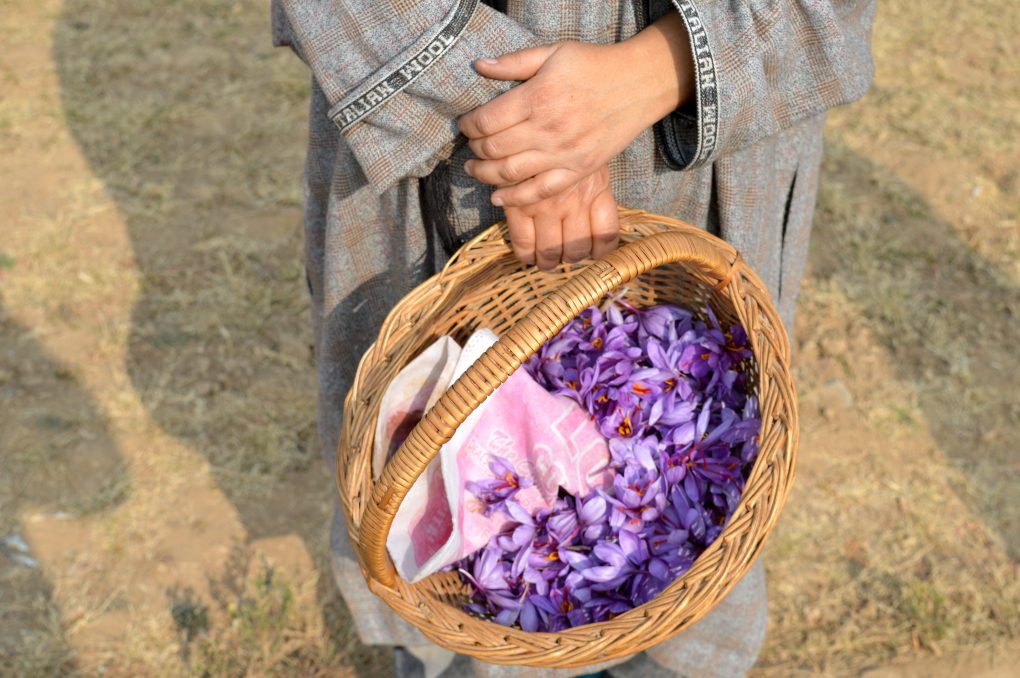“We used to squat and move around slowly in our saffron fields for harvesting bounty crops, but over the past few years the production of saffron flowers has reduced to such a level that we virtually run through the saffron fields while collecting the harvest,” says 68-year-old Ghulam Hassan Rather, as he sits on his knees and scuffs the soil to show the impacts of drought.
Rather has grown saffron for 40 years in his fields that spread over four acres in the Lethpora area of south Kashmir’s Pulwama district. Kashmir received its first proper rainfall in three months on November 18, but not before the highly lucrative saffron crop – fetching around USD 3,000 per kg in the international market – was destroyed. From August to the end of October, the region had just 10 millimetres of rainfall, compared to an average 100 millimetres for the same months, according to Sonum Lotus, director of Srinagar’s regional meteorological department.
Read more: Kashmir’s looming crisis in agriculture
With the exception of 2015 when the crop was good, droughts or untimely excess rainfall have repeatedly damaged saffron crops in recent years, say farmers. According to Rather, every farmer used to harvest around 50 tola (600 grammes) per kanal (one-eighth of an acre), which has reduced to around 150 grammes since 2009.
This year, the worst ever for saffron, farmers didn’t get even that much. “We had the most terrible experience of our life-time. We got just five to 10% of what we had last year,” Rather tells indiaclimatedialogue.net.
Saffron, widely known as the king of spices, is grown in Kashmir, Iran, Spain and, recently, in Afghanistan, where saffron fields have given better yields than Kashmir this year and last. Many believe it can tempt Afghanistan’s farmers away from opium poppy cultivation.
Quoting the success of saffron in Afghanistan, Kashmiri farmers draw consolation from seeing the funny side of their failing crops. “Five years back, Afghanistan’s experts and farmers visited our fields to get a sense of how we grow saffron,” says Showkat Ahmad Shah, a saffron grower in Lethpora. “And now, there are chances we might end up assuming the role of Afghanistan’s farmers considering our repeated saffron-crop failures.”
Rain-fed saffron industry

Supporting around 20,000 families, the saffron industry is the second largest industry in Kashmir, after horticulture. But according to Kashmir’s agriculture department, land for saffron has reduced from 5,700 hectares in the 1990s to 3,715 hectares in 2016, while per hectare production has decreased to less than 1.88 kilograms compared to around six kilograms in other parts of the world.
“The success of saffron crop is entirely dependent on rains. If it rains three to four times between August and November, we get a good crop. If it doesn’t rain as per the need, the crop suffers extensive damage,” says Rather. This year, there was no rainfall from August to November.
Read more: The disappearing water bodies in Kashmir
Firdous Ahmad Nahvi has carried out extensive research on saffron and has helped the government design a project to help farmers tide over droughts and technical difficulties. He says that irrigation is the real reason saffron yield is on the decline.
“Creating irrigation facilities was the critical part of the project [I designed] because we have observed, in recent years, that it doesn’t rain when the crop needs the moisture,” Nahvi told indiaclimatedialogue.net.
Rainfall in the months of September and October becomes an issue, which is being observed more intensely in recent years.
“If it doesn’t rain in these months, the flowering is delayed due to delayed sprouting which does not correlate with critical limits of day and night temperature, thereby, affecting crop productivity,” says Nahvi.
Until 2000, Kashmir received well-distributed precipitation to the extent of 1,000 – 1,200 millimetres, which has decreased to 600 – 800 millimetres.
Dejected farmers
As Rather speaks, dejected farmers carrying wicker-baskets and bags in their hands hurry through their saffron fields to collect the sparsely-spread saffron flowers.
Shakir Ahmad Sofi, in his late 20s, says that he vividly remembers times in his childhood when Pampore’s saffron fields would look festive and quickly turn into market places at harvesting time. The annual activity, he said, was aptly called the Saffron Festival.
“Small traders used to set up their kiosks and stalls to sell their products to people in lieu of saffron,” Shakir tells indiaclimatedialogue.net as he moves around to spot saffron flowers. “We used to derive great enjoyment from the festive mood, and we used to get good pocket money. Now, we find it boring when our parents ask us to work and collect the harvest from the fields.”
Rafeeqa Begam says that women used to take their own shares from the saffron harvest. “We used to sell our share on our own for buying different things including jewellery. But now, because of frequent droughts, we are unable to make the same money.”
As he pulls over his tractor on a bumpy track, farmer Ghulam Mohammad tells indiaclimatedialogue.net that he is carrying water containers to irrigate his saffron crop. “This is what some of us are doing now. We are taking water from a long distance to keep the soil of our saffron lands moist, so that the seeds stay in proper health until the next crop,” says Mohammad, expressing his dejection over the government’s failure to provide drip irrigation facilities.
“As you can see, they have kept those pipes there for display only. They are of no use. If they had any utility, our saffron fields would have been irrigated,” he says, adding that it would take around 80 trips to irrigate his crop.
Failed drip-irrigation scheme
In 2010, the central government in New Delhi launched an INR 3.71 billion national mission to rejuvenate saffron cultivation in Kashmir, later upgraded to INR 4.1 billion.
Creating sprinkler irrigation facilities for saffron cultivation, which has traditionally been dependent on rain, was one of the basic objectives of the mission. But farmers in Lethpora, home to most of Kashmir’s saffron farmers, said that their concerns about irrigation are yet to be addressed.
Read more: Government gives Kashmir saffron growers a helping hand
“The most important thing the government was supposed to do for us was to make water available for our crops. Though a few tube-wells have been dug in some places, we are yet to see the water in saffron fields,” Imtiyaz Ahmad Bhat, a farmer, tells indiaclimatedialogue.net.
Some INR 2 billion was intended for creating sprinkler irrigation facilities for the crop. The money has been almost entirely spent, and officials have held the land mafia responsible for the situation.
A top official of Kashmir’s Mechanical Engineering Department – which was assigned the job of creating the irrigation facilities – said: “[The land mafia] did create problems indirectly at one or two places, but it was not the only reason why the irrigation facility is yet to be created effectively. It became an excuse for the department to hide its sluggishness.” Speaking on the condition of anonymity, the official said that his department has been unable to coordinate between the many companies involved in the project.
This article first appeared on indiaclimatedialogue.net.
